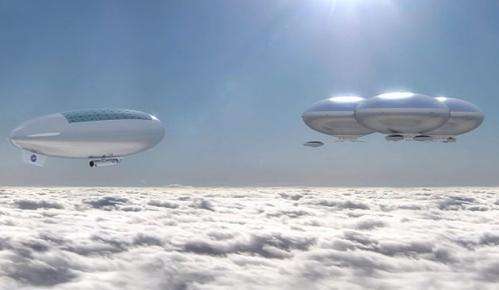HAVOC. Credit: NASA Langley Research Center
(Phys.org) —NASA's Systems Analysis and Concepts Directorate has issued a report outlining a possible way for humans to visit Venus, rather than Mars—by hovering in the atmosphere instead of landing on the surface. The hovering vehicle, which they call a High Altitude Venus Operational Concept (HAVOC), would resemble a blimp with solar panels on top, and would allow people to do research just 50 kilometers above the surface of the planet.
Most everyone knows that NASA wants to send people to Mars—that planet also gets most of the press. Mars is attractive because it looks more like Earth and is relatively close to us. The surface of Venus on the other hand, though slightly closer, is not so attractive, with temperatures that can melt lead and atmospheric pressure 92 times that of Earth. There's also that thick carbon dioxide atmosphere with sulfuric acid clouds, lots of earthquakes, volcanoes going off and terrifying lightning bolts. So, why would anyone rather go to Venus than Mars? Because of far lower radiation and much better solar energy.
No one wants to go the surface of Venus, at least not anytime soon, instead, researchers at NASA are looking into the possibility of sending people to hover in the sky above the planet, conducting research in a far less dangerous place than even on the surface of Mars. At 50 kilometers up, an HAVOC would experience just one atmosphere of atmospheric pressure and temperatures averaging just 75 degrees Celsius, with radiation levels equivalent to those in Canada. Astronauts on Mars, on the other hand would experience 40 times the amount of radiation typically faced back here on Earth, which suggests they'd have to live deep underground to survive—a problem that scientists have not yet solved.
The one hitch to floating around Venus, would of course be, figuring out how to get both humans and an HAVOC to the planet, and then for getting the humans back home safely to Earth at some point. The initial plans call for a several missions, building up to the final, with space ships first carrying unmanned vehicles to test the concept of an HAVOC, followed by missions where humans would orbit the planet in space. Next, scientists would have to come up with a feasible design for deploying a floating vehicle able to unfurl, fill itself with gas, and hover for long stretches of time in the sky above the planet. After that, vehicles would have to be designed to work with such a craft, to serve as a ferry between the HAVOC and an orbiting craft, to travel back and forth to Earth, and perhaps between a craft that orbits Earth and the surface. A lot of work, no doubt, but one that seems possible even as more and more space scientists are begining to wonder about the feasibility of sending humans to the surface of Mars.
More information: via IEEE Spectrum
© 2014 Phys.org
























